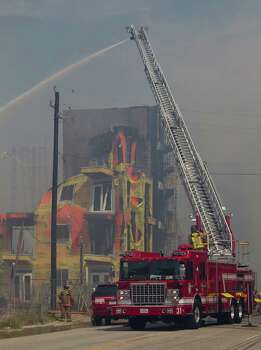Last month's dramatic fire, which destroyed a huge luxury apartment community still under construction in Montrose, dramatically illustrates much of what is wrong with multifamily residential construction in modern-day America. To effect a slight savings, real estate developers, builders and architects increasingly are using building materials that actually contribute to fire disasters. Building codes in Houston and many other cities compound the problem by not requiring stronger fire barriers.
Like the Montrose project, new multifamily residential structures are commonly made up of wood-frame buildings with gypsum wallboard on the inside and masonry, artificial stucco, simulated wood siding or a combination thereof on the outside. This is usually done legally and in accordance with generally accepted building codes, which is part of the problem.
Certain building codes, such as the International Building Code and the International Residential Code, actually have become weaker over the years in some important aspects. The latest International Building Code incorporates the least restrictive provisions of the former three building codes, and actually represents a reduction in fire and life safety. Like all Texas cities, state law requires Houston to adopt the International Building Code as the basis for its building code, although any city can amend it - as in, strengthen it - within some limitations.
Gypsum wallboard, for example, has gained acceptance for use in fire barriers and separators, with its advocates arguing that gypsum is not combustible in laboratory tests. Technically, gypsum is not combustible, but other testing by Underwriters Laboratories, an independent product-safety certification organization, has shown that fire can destroy the taping used for the installation of gypsum wallboard or penetrate other openings and ultimately cause the wallboard to crumble, losing all structural integrity and allowing fire to spread.
Indeed, for gypsum wallboard to be at all effective even in slowing down a fire, the system of walls, ceilings and doors must be completely intact - no holes, cracks of gaps. Otherwise, the system is compromised and will allow flames to spread. In other words, it is almost impossible to have a normal interior living space that is not compromised from a fire-protection perspective.
In the case of the Montrose apartment project, some sections were more nearly finished than others, but the combination of plenty of fuel, wind and no containment whatsoever spelled doom for the structure.
That's why after a catastrophic fire such as the Montrose event, the only building elements left standing are the masonry walls, masonry-enclosed stairwells and masonry-enclosed elevator shafts. The reason is that masonry - brick, natural stone, and concrete block - neither burns nor loses its structural integrity, even in large fires.
Even this picture may change in the near future, however, because the building code now allows gypsum wallboard to be used for enclosing stairwells - primary escape routes - and elevator shafts.
Knowing that we are building dwellings made from materials that add fuel to fires, we must take special measures to reduce the fire risk. Increasingly, cities, including Houston, are requiring that all new multi-family residential structures, not including duplexes, have both smoke alarms and fire sprinklers throughout.
These systems are necessary, but they have problems, too. They provide a false sense of security and encourage the use of more materials that fuel fires. Furthermore, any electrical or mechanical system can fail for a variety of reasons - improper installation, poor maintenance and low water pressure, for example - and sprinkler systems are not always sufficient to suppress all fires.
A multi-pronged strategy is much better: detection (smoke alarms), suppression (fire sprinklers) and containment (fire walls). For effective fire protection, you must have all three. (As far as the insurance industry is concerned, fire walls are made only of masonry, usually reinforced concrete block or brick.)
The Montrose fire became catastrophic because it spread rapidly. The increasing use of lighter and cheaper construction materials for fire barriers between units also means that these structures are weaker and more susceptible to collapse in a fire, thus threatening firefighters as well as occupants.
Fires during construction can be particularly devastating as the lumber is often unprotected and there is little to prevent flames from spreading quickly. A completed and occupied building's risk, however, is not any less and results may be more catastrophic as sudden and faster structural failure, collapse of roof and floor trusses may trap occupants or limit their ability to escape.
Coincidentally, one day after the apartment project fire, there was another spectacular fire at a nearby century-old church. The fire was traced to an electrical problem. The damage was considerable, but fire officials said brick fire walls in the attic prevented the fire from spreading and destroying the entire structure.
Current building codes allow for gypsum fire-resistant barriers between units. But fire spreads more rapidly when the gypsum walls collapse. Fire walls, in contrast, don't burn at all, and, if built properly, don't collapse. Houston saw the tragic consequences of the absence of fire walls last year on May 31, when four firefighters died in a hotel fire.
In Texas, local governments have the power and the responsibility to safeguard the population by strengthening building codes. As we consider the Montrose fire and approach the first anniversary of the tragic hotel fire, theHouston City Council should stop settling for half-measures and adopt fire protection standards that actually save lives and property. It should require fire walls, as well as sprinklers and smoke alarms, in all new multifamily residential construction.
Darwish is an associate professor of construction engineering at Texas Tech University.





No comments:
Post a Comment